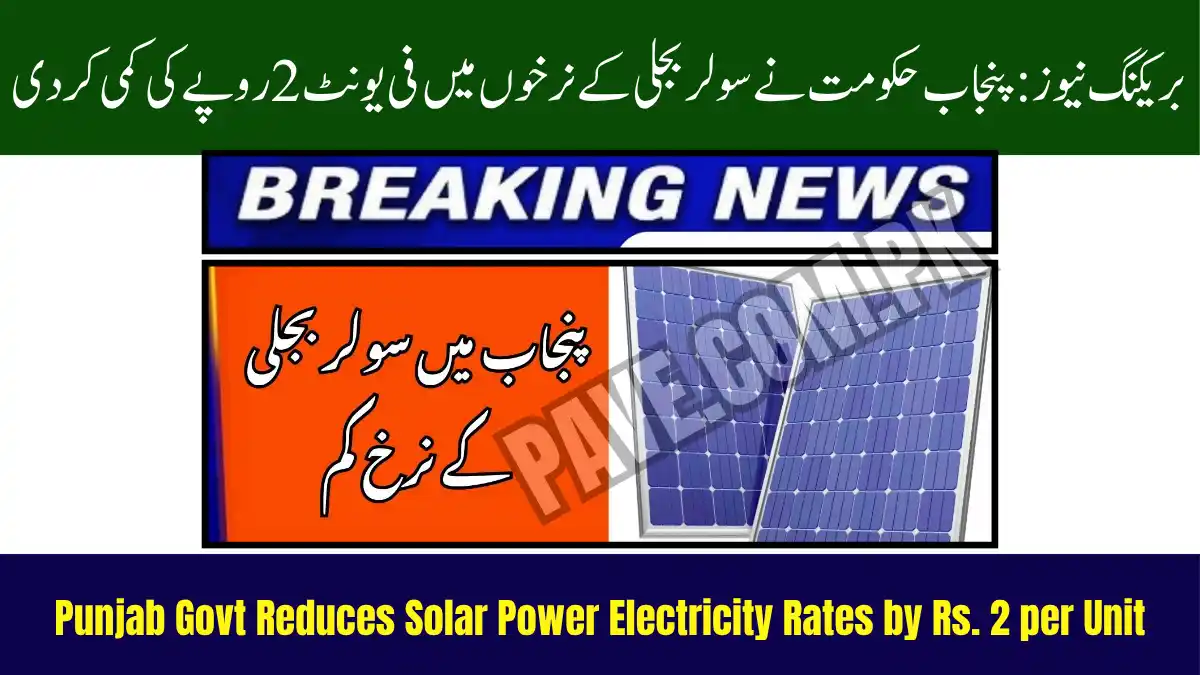Breaking News: Punjab Govt Reduces Solar Power Electricity Rates by Rs. 2 per Unit
In a significant step toward affordable and sustainable energy, Chief Minister Maryam Nawaz Sharif has announced a Rs. 2 per unit reduction in solar power electricity rates across Punjab. The decision, made during the 29th Punjab Cabinet Meeting, marks a major relief for residential and commercial consumers who have shifted—or plan to shift—to solar power.
This development reinforces the Punjab government’s commitment to green energy, economic stability, and public welfare, aligning with Maryam Nawaz’s broader Clean and Affordable Energy Vision 2025. The move is expected to encourage more households and businesses to adopt renewable energy as the primary source of power.
💡 Solar Power Update – A Step Toward Energy Independence
The Solar Power Electricity Rates Reduced in Punjab 2025 decision will immediately benefit thousands of consumers already connected to the net metering system. With electricity costs dropping by Rs. 2 per unit, Punjab residents will enjoy substantial savings on their monthly bills while contributing to a greener environment.
Maryam Nawaz emphasized that Punjab’s energy policy focuses on:
- Affordable solar power for every household
- Promotion of renewable energy and local manufacturing
- Reducing reliance on imported fossil fuels
- Encouraging rooftop solar projects for homes and small industries
According to the new plan, the Punjab Energy Department will also expand solar installations across government buildings, schools, and hospitals—turning Punjab into a solar-powered province by 2030.
Read More: Punjab Pushes Clean Energy Drive Colleges Going Fully Solar in 2025
⚙️ Details from the 29th Punjab Cabinet Meeting
During the 29th Cabinet session, chaired by CM Maryam Nawaz, several key welfare measures were approved, including this landmark solar tariff reduction. Officials confirmed that this step aims to balance the growing demand for affordable energy with the government’s climate-friendly goals.
The session also reviewed ongoing progress on the Punjab Solar Village Project, which provides subsidized solar panels to low-income families and farmers under easy payment plans.
🌊 Flood Relief Package – Support for Affected Families
Another major highlight from the meeting was the approval of the Punjab Flood Relief Package 2025. The government has allocated significant funds to assist families impacted by recent floods.
Here’s the detailed compensation breakdown:
| Category | Compensation Amount |
|---|---|
| Families of deceased individuals | Rs. 10 lakh |
| Permanent disability | Rs. 5 lakh |
| Partial disability | Rs. 3 lakh |
| Fully destroyed brick house | Rs. 10 lakh |
| Partly damaged brick house | Rs. 3 lakh |
| Destroyed mud house | Rs. 5 lakh |
| Minor damage | Rs. 1.5 lakh |
| Loss of big animals | Rs. 5 lakh |
| Loss of small animals | Rs. 50,000 |
The relief checks will be distributed starting October 17, 2025, through district administration offices. Maryam Nawaz has instructed all departments to ensure transparent and speedy compensation to avoid delays.
🎓 Education Reforms – Affordable Learning for All
In a strong stance for educational equality, CM Maryam Nawaz rejected a proposal to double the MBBS fee for overseas Pakistani students from USD 10,000 to USD 20,000.
She stated,
“Education is not a privilege for the few—it’s a right for every Pakistani, whether at home or abroad.”
The government has officially set the annual MBBS fee at USD 10,000 for overseas students. Additionally, students from other provinces who wish to study in Punjab’s medical colleges must pass the MDCAT examination, ensuring merit-based admissions.
This move reflects the Punjab government’s commitment to accessible education, particularly in professional fields like medicine and engineering.
⚡ Broader Impact – Relief for Public & Boost for Renewable Energy
The Solar Power Electricity Rates Reduced in Punjab 2025 initiative will have far-reaching economic and environmental benefits. It will:
- Lower electricity costs for millions of citizens
- Encourage private investment in solar energy
- Reduce the national grid’s burden during peak demand
- Create new green jobs in manufacturing, installation, and maintenance sectors
Economists predict that this policy could save Punjab’s consumers over Rs. 30 billion annually while reducing the province’s carbon footprint by 20% within the next three years.
🏠 Clean Energy for Every Household
To ensure that solar power becomes a household reality, the Punjab government is also expanding its Solar Rooftop Program and Kisan Solar Tube Well Scheme. Farmers and small business owners can now apply for interest-free solar financing through the Bank of Punjab (BOP) and Punjab Energy Development Board (PEDB).
The program will especially target rural communities, enabling them to replace expensive diesel-powered systems with clean and cost-effective solar alternatives.
Read More: Punjab Decides to Shift 355 Colleges to Solar Energy Including Lahore
🗣️ Public Response
Social media users across Punjab have praised the initiative, calling it a “bold and visionary step.” Many expressed gratitude for Maryam Nawaz’s leadership in prioritizing clean energy and public relief over politics.
“This is real change—solar energy for the people, not just slogans,” commented one user on X (formerly Twitter).
The announcement also trended on Google under searches like Solar Power Electricity Rates Punjab 2025 and Maryam Nawaz Solar Policy Update.
🧭 Final Words
The Punjab Solar Power Electricity Rates Reduction 2025 reflects Maryam Nawaz’s forward-thinking governance—a blend of environmental responsibility, economic relief, and social progress. By cutting solar electricity rates, introducing flood compensation, and maintaining affordable education, her government has once again proven its people-first agenda.
As Punjab moves toward a cleaner and more energy-independent future, this decision stands as a beacon of progress for the rest of Pakistan.
“Clean Energy, Affordable Punjab – Powered by Maryam Nawaz.” 🌞







